Abstract
1. Inotropic changes in the left ventricle in chloralose anaesthetized dogs were determined in response to changes in non-pulsatile pressure perfusing the vascularly isolated aortic arch.
2. Inotropic responses were assessed by measuring the maximum rate of change of left ventricular pressure (dP/dt max) in preparations in which heart rate, mean ascending aortic pressure and brachiocephalic (i.e. carotid sinus and cerebral) perfusion pressure were held constant.
3. dP/dt max increased (average +43%) when aortic pressure was reduced from a level above that which produced maximum depression of the myocardium to a level below which no further responses could be obtained; responses occurred as aortic arch pressure was changed between 250 and 90 mm Hg.
5. In the same preparations changes in the brachiocephalic artery perfusion pressure with aortic arch pressure held constant resulted in similar inotropic responses.
6. It is suggested that aortic arch baroreceptors may be of importance in the control of the inotropic state of the heart.
Full text
PDF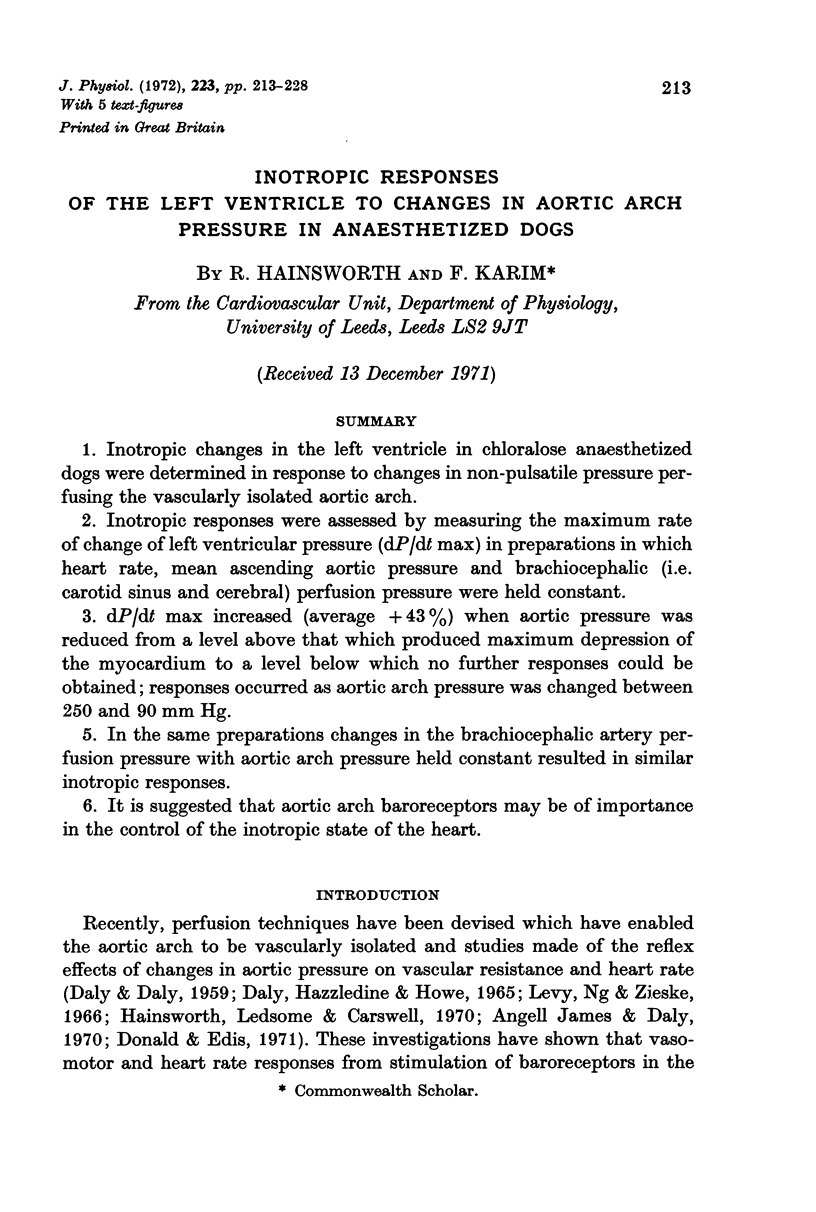
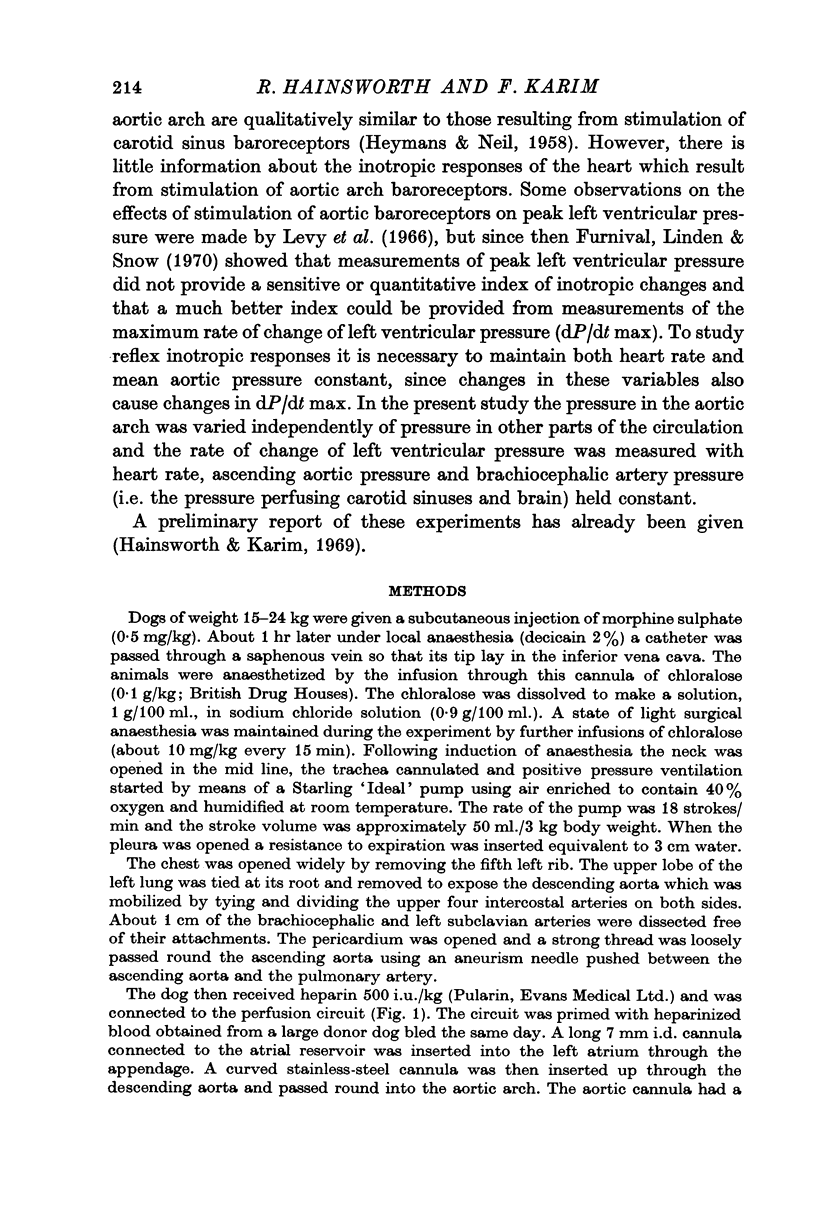
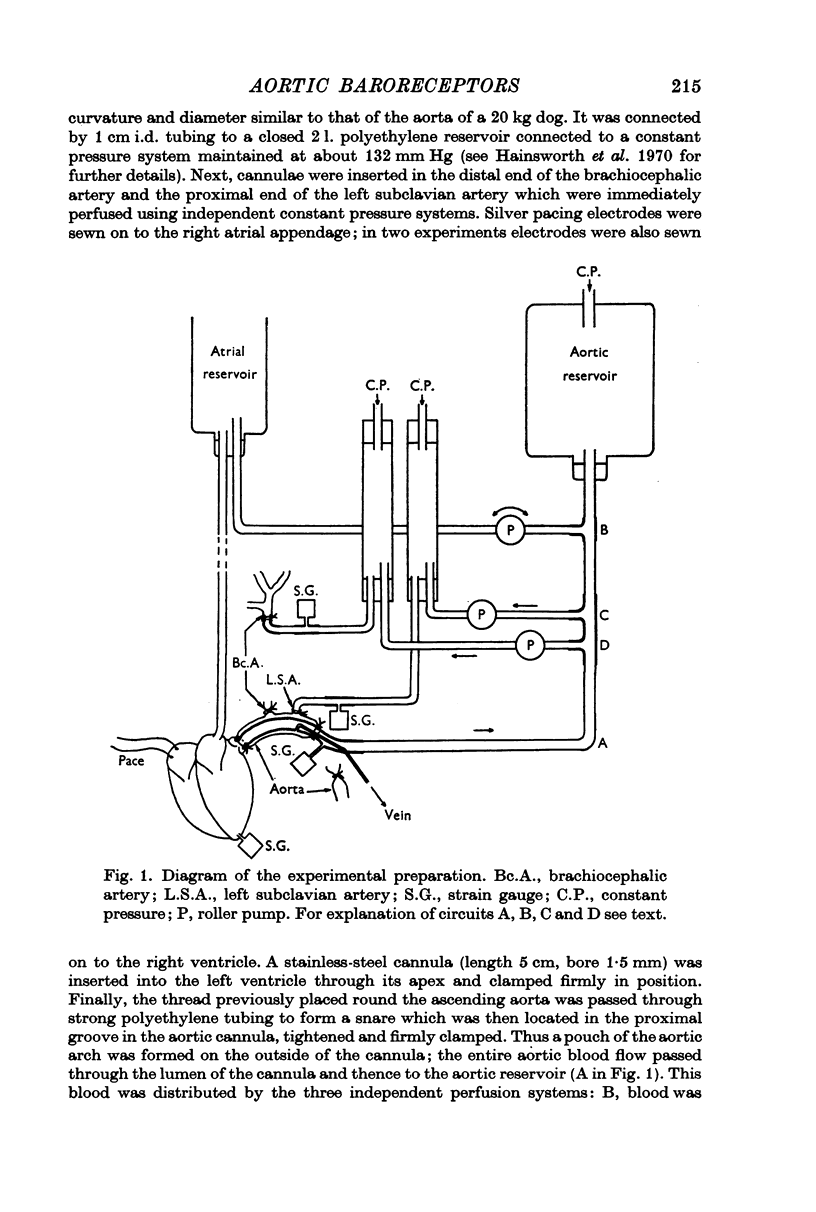
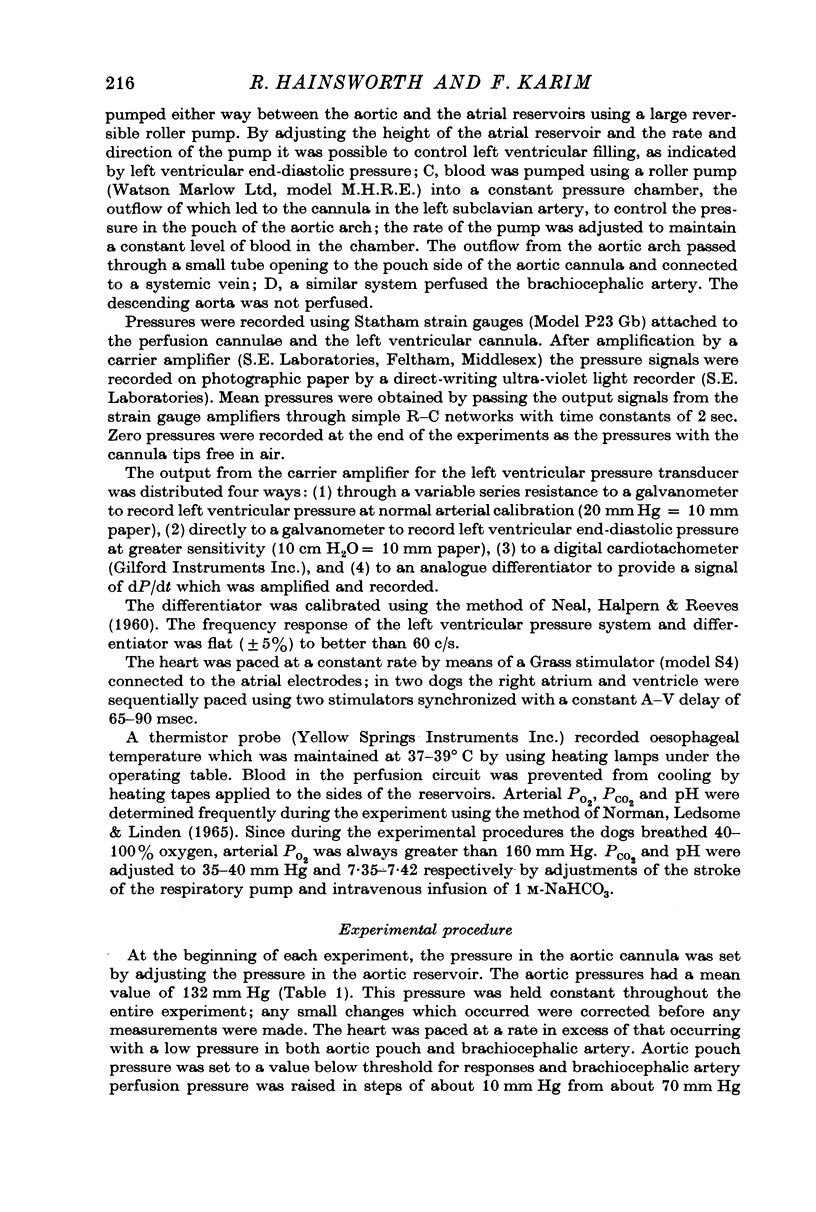


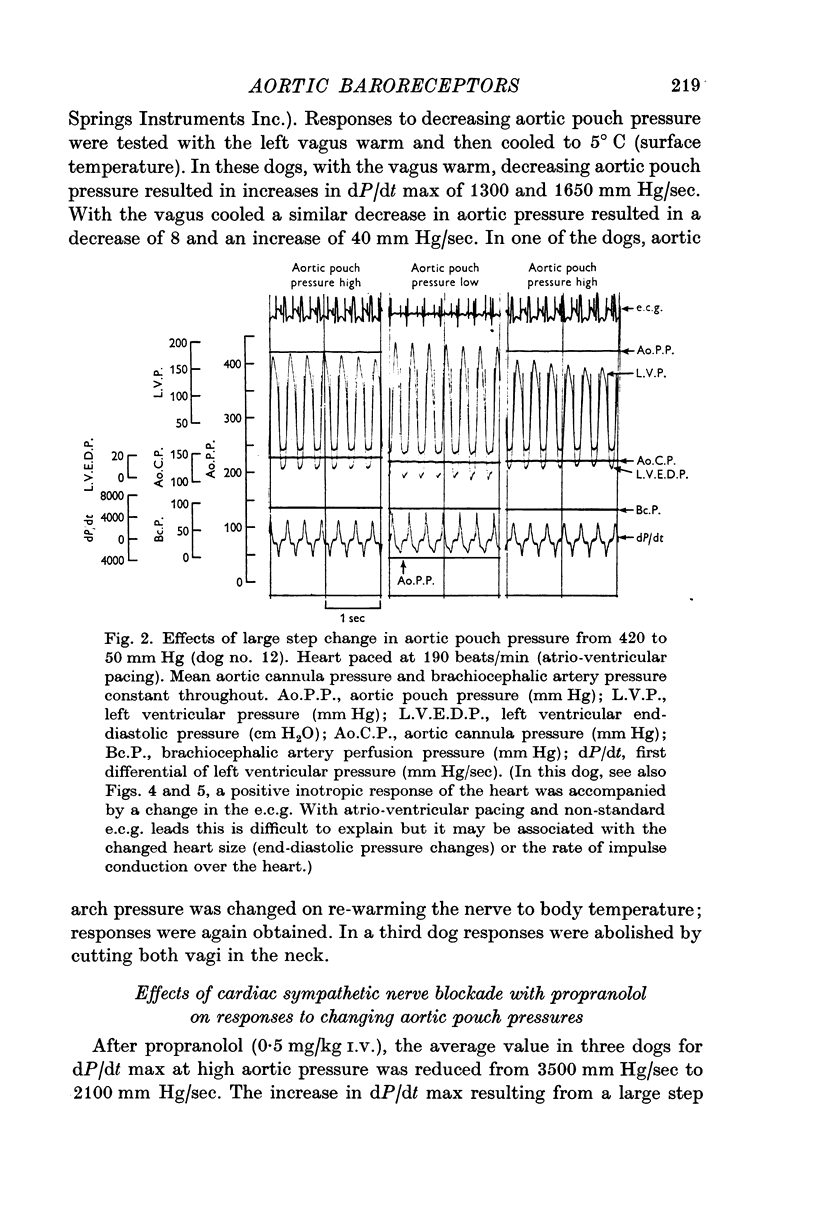
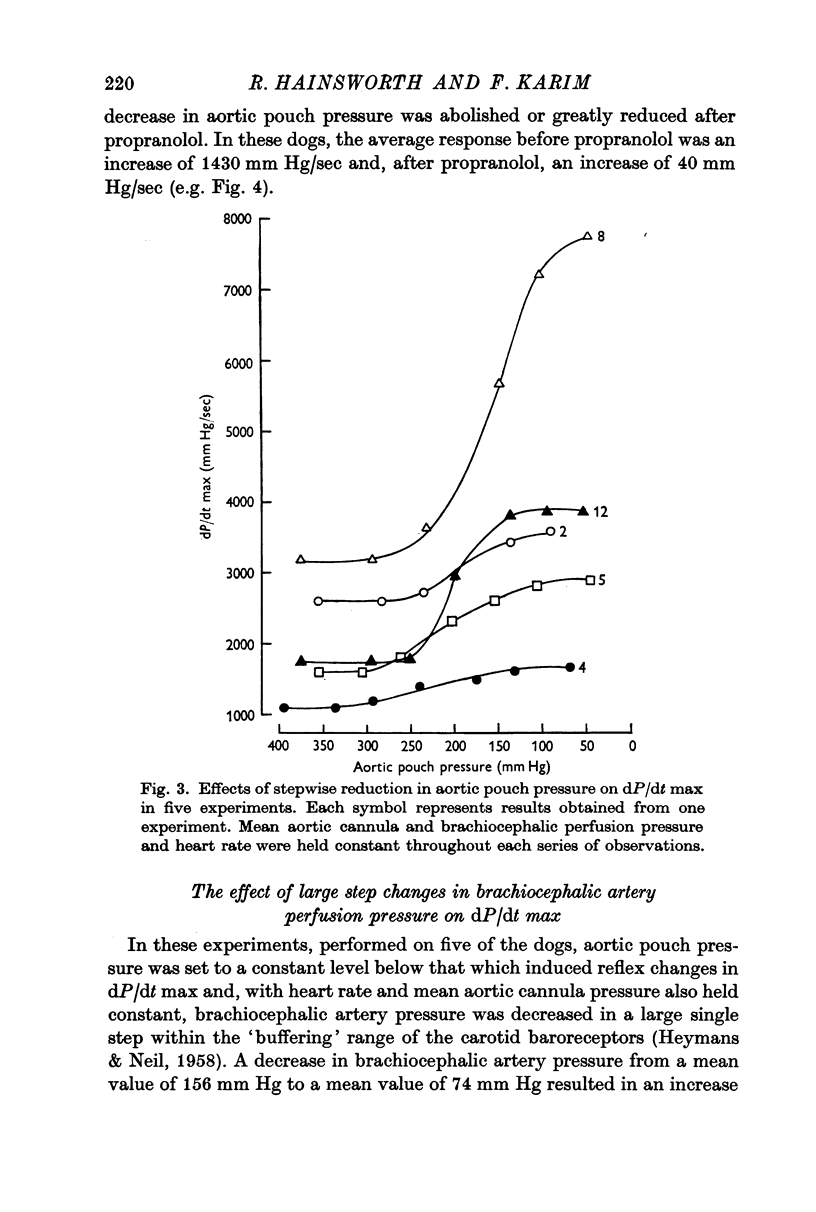

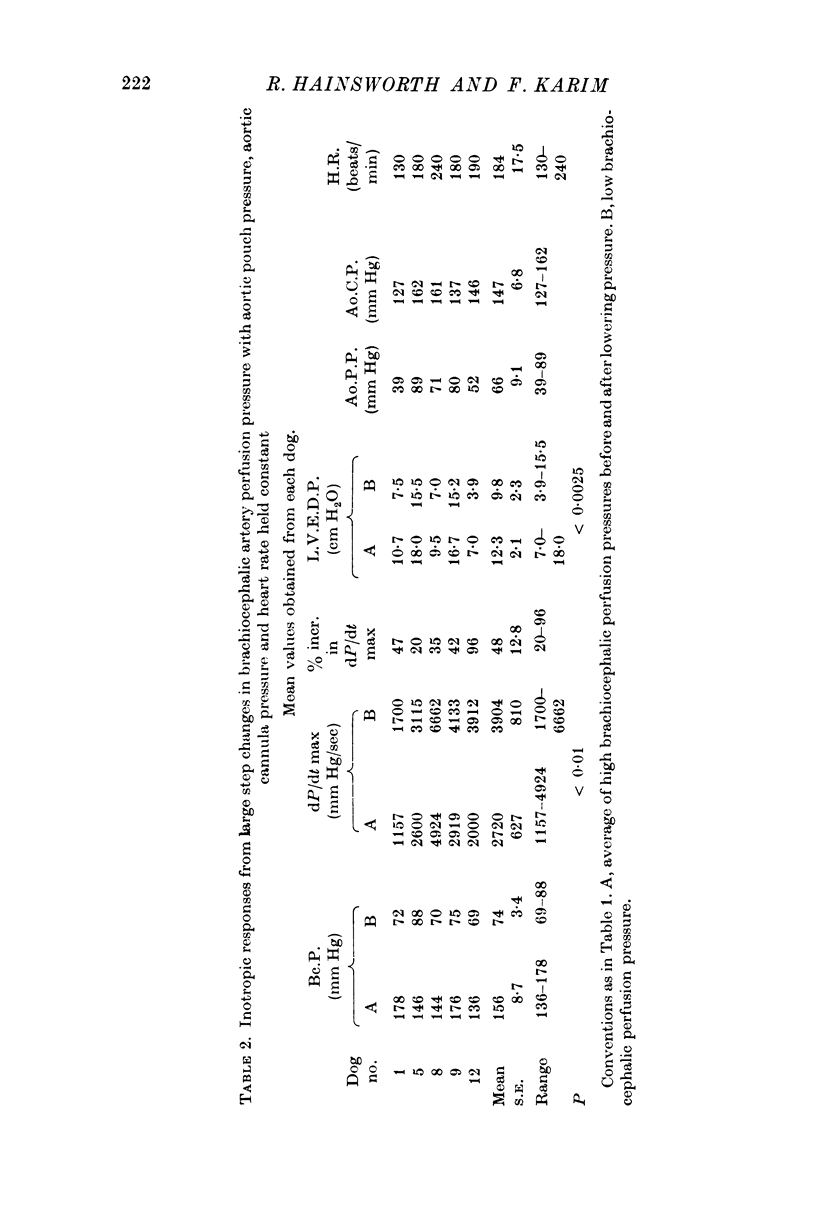

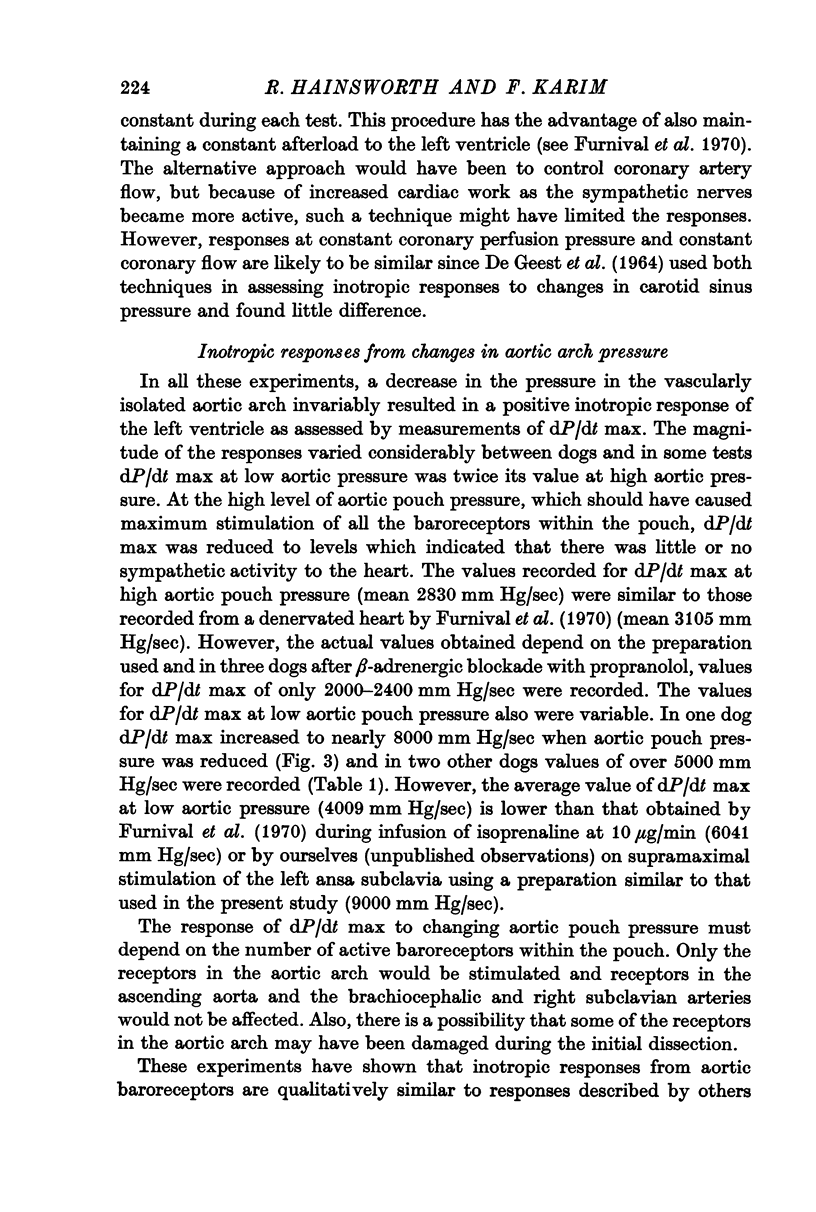


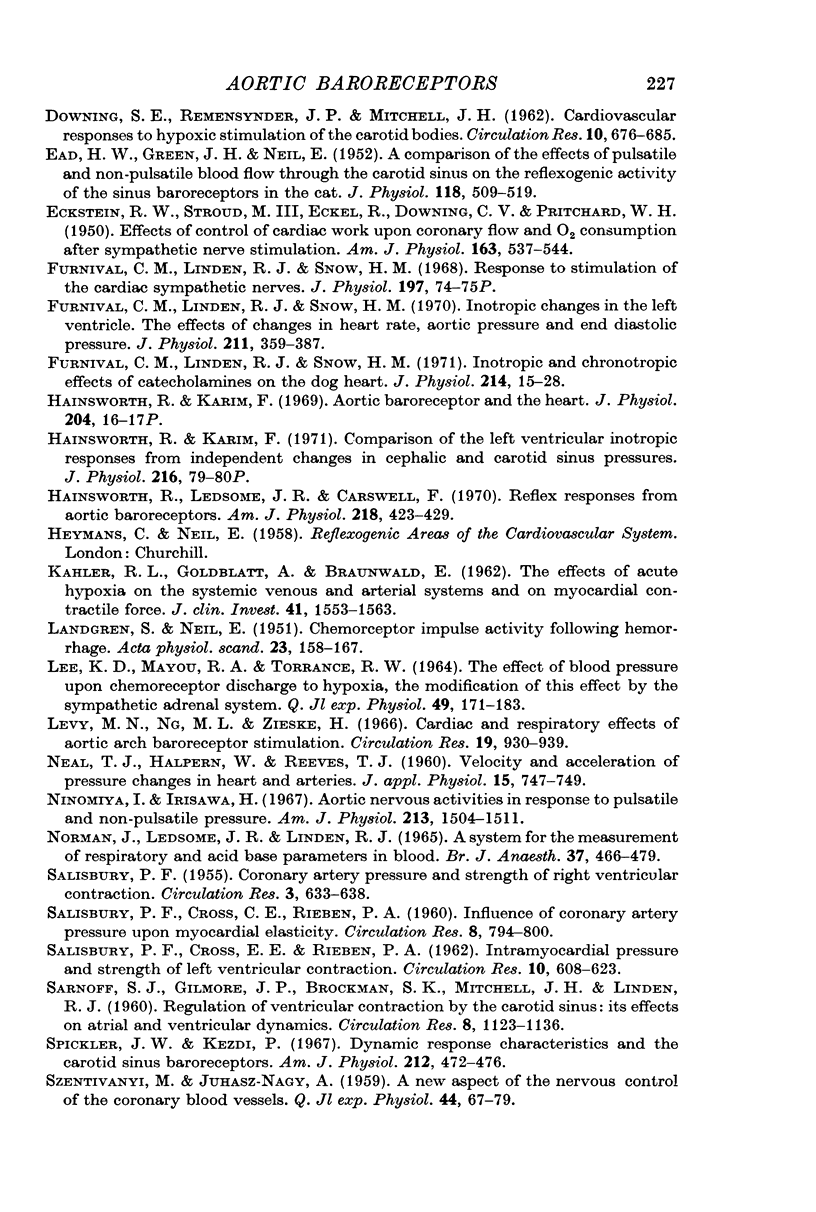
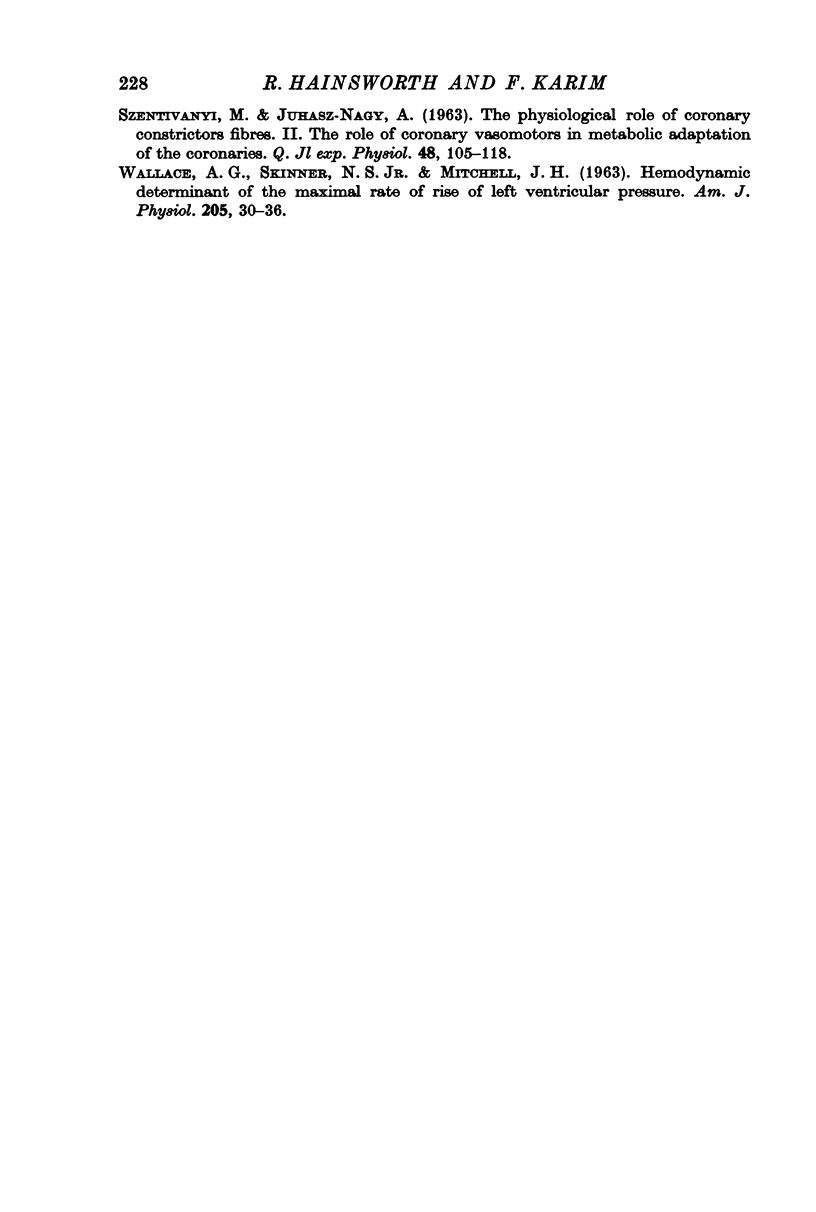
Selected References
These references are in PubMed. This may not be the complete list of references from this article.
- Abel R. M., Reis R. L. Effects of coronary blood flow and perfusion pressure on left ventricular contractility in dogs. Circ Res. 1970 Dec;27(6):961–971. doi: 10.1161/01.res.27.6.961. [DOI] [PubMed] [Google Scholar]
- Arnold G., Morgenstern C., Lochner W. The autoregulation of the heart work by the coronary perfusion pressure. Pflugers Arch. 1970;321(1):34–55. doi: 10.1007/BF00594121. [DOI] [PubMed] [Google Scholar]
- BERNE R. M., DEGEEST H., LEVY M. N. INFLUENCE OF THE CARDIAC NERVES ON CORONARY RESISTANCE. Am J Physiol. 1965 Apr;208:763–769. doi: 10.1152/ajplegacy.1965.208.4.763. [DOI] [PubMed] [Google Scholar]
- BERNE R. M., LEVY M. N. HEART. Annu Rev Physiol. 1964;26:153–186. doi: 10.1146/annurev.ph.26.030164.001101. [DOI] [PubMed] [Google Scholar]
- CROSS C. E., RIEBEN P. A., SALISBURY P. F. Influence of coronary perfusion and myocardial edema on pressure-volume diagram of left ventricle. Am J Physiol. 1961 Jul;201:102–108. doi: 10.1152/ajplegacy.1961.201.1.102. [DOI] [PubMed] [Google Scholar]
- DALY I. D., DALY M. D. The effects of stimulation of the carotid sinus baroreceptors on the pulmonary vascular bed in the dog. J Physiol. 1959 Oct;148:220–226. doi: 10.1113/jphysiol.1959.sp006283. [DOI] [PMC free article] [PubMed] [Google Scholar]
- DALYMDE B., HAZZLEDINE J. L., HOWE A. REFLEX RESPIRATORY AND PERIPHERAL VASCULAR RESPONSES TO STIMULATION OF THE ISOLATED PERFUSED AORTIC ARCH CHEMORECEPTORS OF THE DOG. J Physiol. 1965 Mar;177:300–322. doi: 10.1113/jphysiol.1965.sp007593. [DOI] [PMC free article] [PubMed] [Google Scholar]
- DEGEEST H., LEVY M. N., ZIESKE H., Jr CAROTID SINUS BARORECEPTOR REFLEX EFFECTS UPON MYOCARDIAL CONTRACTILITY. Circ Res. 1964 Oct;15:327–342. doi: 10.1161/01.res.15.4.327. [DOI] [PubMed] [Google Scholar]
- DENISON A. B., Jr, GREEN H. D. Effects of autonomic nerves and their mediators on the coronary circulation and myocardial contraction. Circ Res. 1958 Sep;6(5):633–643. doi: 10.1161/01.res.6.5.633. [DOI] [PubMed] [Google Scholar]
- DOWNING S. E., REMENSNYDER J. P., MITCHELL J. H. Cardiovascular responses to hypoxic stimulation of the carotid bodies. Circ Res. 1962 Apr;10:676–685. doi: 10.1161/01.res.10.4.676. [DOI] [PubMed] [Google Scholar]
- Donald D. E., Edis A. J. Comparison of aortic and carotid baroreflexes in the dog. J Physiol. 1971 Jun;215(2):521–538. doi: 10.1113/jphysiol.1971.sp009483. [DOI] [PMC free article] [PubMed] [Google Scholar]
- EAD H. W., GREEN J. H., NEIL E. A comparison of the effects of pulsatile and non-pulsatile blood flow through the carotid sinus on the reflexogenic activity of the sinus baroceptors in the cat. J Physiol. 1952 Dec;118(4):509–519. doi: 10.1113/jphysiol.1952.sp004812. [DOI] [PMC free article] [PubMed] [Google Scholar]
- ECKSTEIN R. W., STROUD M., 3rd, ECKEL R., DOWLING C. V., PRITCHARD W. H. Effects of control of cardiac work upon coronary flow and O2 consumption after sympathetic nerve stimulation. Am J Physiol. 1950 Dec;163(3):539–544. doi: 10.1152/ajplegacy.1950.163.3.539. [DOI] [PubMed] [Google Scholar]
- Furnival C. M., Linden R. J., Snow H. M. Inotropic changes in the left ventricle: the effect of changes in heart rate, aortic pressure and end-diastolic pressure. J Physiol. 1970 Dec;211(2):359–387. doi: 10.1113/jphysiol.1970.sp009283. [DOI] [PMC free article] [PubMed] [Google Scholar]
- Furnival C. M., Linden R. J., Snow H. M. Response to stimulation of the cardiac sympathetic nerves. J Physiol. 1968 Jul;197(1):74P–75P. [PubMed] [Google Scholar]
- Furnival C. M., Linden R. J., Snow H. M. The inotropic and chronotropic effects of catecholamines on the dog heart. J Physiol. 1971 Apr;214(1):15–28. doi: 10.1113/jphysiol.1971.sp009416. [DOI] [PMC free article] [PubMed] [Google Scholar]
- Hainsworth R., Karim F. Aortic baroreceptors and the heart. J Physiol. 1969 Sep;204(1):16P–17P. [PubMed] [Google Scholar]
- Hainsworth R., Karim F. Comparison of the left ventricular inotropic responses from independent changes in cephalic and carotid sinus pressures. J Physiol. 1971 Jul;216(2):79P–80P. [PubMed] [Google Scholar]
- Hainsworth R., Ledsome J. R., Carswell F. Reflex responses from aortic baroreceptors. Am J Physiol. 1970 Feb;218(2):423–429. doi: 10.1152/ajplegacy.1970.218.2.423. [DOI] [PubMed] [Google Scholar]
- James J. E., Daly M. de B. Comparison of the reflex vasomotor responses to separate and combined stimulation of the carotid sinus and aortic arch baroreceptors by pulsatile and non-pulsatile pressures in the dog. J Physiol. 1970 Aug;209(2):257–293. doi: 10.1113/jphysiol.1970.sp009165. [DOI] [PMC free article] [PubMed] [Google Scholar]
- James J. E. The responses of aortic arch and right subclavian baroreceptors to changes of non-pulsatile pressure and their modification by hypothermia. J Physiol. 1971 Apr;214(2):201–223. doi: 10.1113/jphysiol.1971.sp009428. [DOI] [PMC free article] [PubMed] [Google Scholar]
- KAHLER R. L., GOLDBLATT A., BRAUNWALD E. The effects of acute hypoxia on the systemic venous and arterial systems and on myocardial contractile force. J Clin Invest. 1962 Jul;41:1553–1563. doi: 10.1172/JCI104612. [DOI] [PMC free article] [PubMed] [Google Scholar]
- LANDGREN S., NEIL E. Chemoreceptor impulse activity following haemorrhage. Acta Physiol Scand. 1951 Aug 25;23(2-3):158–167. doi: 10.1111/j.1748-1716.1951.tb00805.x. [DOI] [PubMed] [Google Scholar]
- LEE K. D., MAYOU R. A., TORRANCE R. W. THE EFFECT OF BLOOD PRESSURE UPON CHEMORECEPTOR DISCHARGE TO HYPOXIA, AND THE MODIFICATION OF THIS EFFECT BY THE SYMPATHETIC-ADRENAL SYSTEM. Q J Exp Physiol Cogn Med Sci. 1964 Apr;49:171–183. doi: 10.1113/expphysiol.1964.sp001717. [DOI] [PubMed] [Google Scholar]
- Levy M. N., Ng M. L., Zieske H. Cardiac and respiratory effects of aortic arch baroreceptor stimulation. Circ Res. 1966 Nov;19(5):930–939. doi: 10.1161/01.res.19.5.930. [DOI] [PubMed] [Google Scholar]
- NEAL J. J., Jr, HALPERN W., REEVES T. J. Velocity and acceleration of pressure change in heart and arteries. J Appl Physiol. 1960 Jul;15:747–749. doi: 10.1152/jappl.1960.15.4.747. [DOI] [PubMed] [Google Scholar]
- Ninomiya I., Irisawa H. Aortic nervous activities in response to pulsatile and nonpulsatile pressure. Am J Physiol. 1967 Dec;213(6):1504–1511. doi: 10.1152/ajplegacy.1967.213.6.1504. [DOI] [PubMed] [Google Scholar]
- Norman J., Ledsome J. R., Linden R. J. A system for the measurement of respiratory and acid-base parameters in blood. Br J Anaesth. 1965 Jul;37(7):466–479. doi: 10.1093/bja/37.7.466. [DOI] [PubMed] [Google Scholar]
- SALISBURY P. F., CROSS C. E., RIEBEN P. A. Influence of coronary artery pressure upon myocardial elasticity. Circ Res. 1960 Jul;8:794–800. doi: 10.1161/01.res.8.4.794. [DOI] [PubMed] [Google Scholar]
- SALISBURY P. F., CROSS C. E., RIEBEN P. A. Intramyocardial pressure and strength of left ventricular contraction. Circ Res. 1962 Apr;10:608–623. doi: 10.1161/01.res.10.4.608. [DOI] [PubMed] [Google Scholar]
- SALISBURY P. F. Coronary artery pressure and strength of right ventricular contraction. Circ Res. 1955 Nov;3(6):633–638. doi: 10.1161/01.res.3.6.633. [DOI] [PubMed] [Google Scholar]
- SZENTIVANYI M., JUHASZ NAGY A. A new aspect of the nervous control of the coronary blood vessels. Q J Exp Physiol Cogn Med Sci. 1959 Jan;44(1):67–79. doi: 10.1113/expphysiol.1959.sp001377. [DOI] [PubMed] [Google Scholar]
- SZENTIVANYI M., JUHASZ-NAGY A. The physiological role of coronary constrictor fibres. II. The role of coronary vasomotors in metabolic adaptation of the coronaries. Q J Exp Physiol Cogn Med Sci. 1963 Jan;48:105–118. doi: 10.1113/expphysiol.1963.sp001630. [DOI] [PubMed] [Google Scholar]
- Spickler J. W., Kezdi P. Dynamic response characteristics of carotid sinus baroreceptors. Am J Physiol. 1967 Feb;212(2):472–476. doi: 10.1152/ajplegacy.1967.212.2.472. [DOI] [PubMed] [Google Scholar]
- WALLACE A. G., SKINNER N. S., Jr, MITCHELL J. H. Hemodynamic determinants of the maximal rate of rise of left ventricular pressure. Am J Physiol. 1963 Jul;205:30–36. doi: 10.1152/ajplegacy.1963.205.1.30. [DOI] [PubMed] [Google Scholar]


